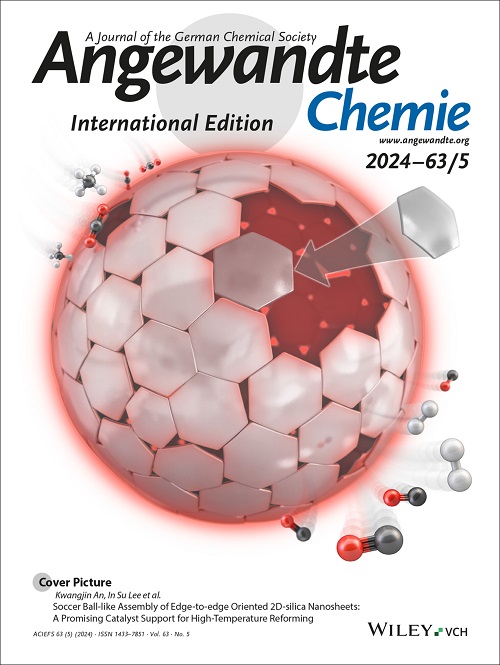MXene负载的Ru-Ni:水解,氢氧化和氢化的常见活性位点
IF 16.1
1区 化学
Q1 CHEMISTRY, MULTIDISCIPLINARY
引用次数: 0
摘要
利用单模催化剂深入了解氢的活化和转化对推进燃料和精细化工生产至关重要。本文研究了RuM (M = Ni, Co, Cu, Fe)‐MXene催化剂上H2分子在制氢过程中的活化和转化及其应用。在ti3c2mxene上均匀分布了RuM (M = Ni, Co, Cu, Fe)双金属纳米团簇。最优Ru2.5Ni2.5‐Ti3C2对氨硼烷(AB, NH3BH3)水解的TOF值最高,为1833 min‐1。同时,催化剂在氢氧化反应(HOR)和苯乙炔加氢反应中也表现出良好的催化活性。其高活性来源于RuNi簇- Ti3C2对催化过程的加速,以及RuNi簇- MXene的特殊界面对分子转运的促进。具有合适d波段的RuNi簇- Ti3C2为H2分子和各种反应中间体的调控活化和转化提供了可靠的平台。展示了纳米簇MXene催化材料在氢的活化和转化方面的竞争力。这项反应诱导适应的研究为探索多功能催化剂在能源、化学和材料方面的应用开辟了途径。本文章由计算机程序翻译,如有差异,请以英文原文为准。
MXene‐supported Ru–Ni: a Common Active Site for Hydrolysis, Hydrogen Oxidation, and Hydrogenation
Insights into the activation and conversion of hydrogen using a single‐mode catalyst is crucial for advancing fuels and fine chemical production. In this paper, the activation and conversion of H2 molecular in hydrogen production and application were investigated on RuM (M = Ni, Co, Cu, Fe)‐MXene catalysts. RuM (M = Ni, Co, Cu, Fe) bimetallic nanoclusters were uniformly distributed on Ti3C2 MXene. The optimal Ru2.5Ni2.5‐Ti3C2 exhibites the highest turnover frequency (TOF) value of 1833 min‐1 toward ammonia borane (AB, NH3BH3) hydrolysis. Meanwhile, the catalysts also showed good catalytic activity in hydrogen oxidation reaction (HOR) and phenylacetylene hydrogenation. The high activity is originl from the acceleration of the catalytic process by RuNi clusters‐Ti3C2 and the promotion of molecular transport by the special interface of RuNi cluster‐MXene. The RuNi clusters‐Ti3C2 with suiable d‐band provide a dependable platform for the regulated activation and conversion of H2 molecules and various reaction intermediates. The competitiveness of nano‐cluster‐MXene catalytic material is showcased for activation and conversion of hydrogen. This research of reaction‐inducing adaptation uncovered the pathway to explore multi‐functional catalysts in energy, chemistry and materials applications.
求助全文
通过发布文献求助,成功后即可免费获取论文全文。
去求助
来源期刊
CiteScore
26.60
自引率
6.60%
发文量
3549
审稿时长
1.5 months
期刊介绍:
Angewandte Chemie, a journal of the German Chemical Society (GDCh), maintains a leading position among scholarly journals in general chemistry with an impressive Impact Factor of 16.6 (2022 Journal Citation Reports, Clarivate, 2023). Published weekly in a reader-friendly format, it features new articles almost every day. Established in 1887, Angewandte Chemie is a prominent chemistry journal, offering a dynamic blend of Review-type articles, Highlights, Communications, and Research Articles on a weekly basis, making it unique in the field.

 求助内容:
求助内容: 应助结果提醒方式:
应助结果提醒方式:


